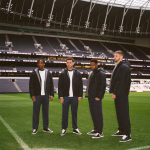
Change the crest will change football
Sport is becoming an industry, will it lose its soul in the process?

April 8th, 2022
Recently thanks to a post circulated widely on Twitter about the rebranding of various European soccer clubs that have chosen the path of minimalism in transforming their logos, many have questioned where that path will eventually lead. If this corporatization of the teams, perpetrated in recent years in an increasingly schematic way - following the same rigid borders that delimit the new crests - could result in choking the tradition and passion that has always animated soccer, what is spiritually defined as the soul of the game.
Football is losing its soul pic.twitter.com/vPa0yiq2te
— dan (@hardmandesign) March 26, 2022
A question that periodically returns to the surface, suspended in a tension between nostalgia and modernity, to which it is difficult to respond with a simple solution. On the one hand, there is the attraction to an idealized past, made up of light-hearted, childlike memories, and the need to constantly innovate in order to keep up with the rest of the leagues and teams. In between are team logos, the symbols designated to keep the relationship with tradition alive and at the same time be the front door for newcomers.
Since the dawn of organized soccer, teams have always included in their crests shapes, colors and elements that fortified the relationship between the club and the city or place of origin. A relationship that has nurtured a love for soccer, that on many occasions has overflowed the simple fascination of 22 men running after a ball, and that touches the most intimate chords of belonging and a sense of community. It is therefore easy to imagine how any alteration to the original coats of arms is seen by many as a bastardization of those values, a dilution of the initial sense that led to the founding of the club.
At the same time, soccer cannot remain crystallized in an eternal present, and like everything else, it must constantly update itself to keep up with the passing of time. In particular, the need to deal with an increasingly globalized world in which clubs have become large conglomerates closer to finance than to the sport played, removing the relationship that was the basis for the construction of such clubs. And this revolution is told by the continuous changes made to the crests, an evolutionary line on which it is possible to read the epochs, fashions and trends of the last hundred years of design. The latest of these is certainly the one that is moving towards a minimalist corporate style, with vector logos that are more suitable to be inserted in an advertising brochure rather than to decorate game jerseys.
Communicability has replaced identity, and this has unleashed the most traditionalist bangs of the fans, who evidently did not like certain changes. Because they were not intended for them but for an audience of neophytes, to whom soccer has never before reached in such a direct way as it can now through the chain of social media and the internet, languages that require a new graphic formulation. The new logos were made to be readable on various formats without creating confusion, in particular to be adaptable in various formats, from the icon for the app in 120px to the print on the game jerseys. A flexibility that was ill-suited to the old logos that were hand-drawn and often not congruent with each other.
A distance between analog and digital that could be a metaphor of our times, and that divides two different ways of understanding the purposes of sport or considering the ultimate goals of a soccer team. Even the semantic division that is proposed today between coats of arms and logos, the former associated with the medieval heraldry of the football tradition and the latter with corporate standardization, stems from a need for a black&white opposition and is therefore ultimately false.
Probably the truth, as often happens, lies in the middle, in a space that should be cultivated by the passion for football and for the challenges that the future holds without, however, expiring in the uncritical exaltation of the past. Perhaps a pinch of iconoclasm in a world dominated by symbols cannot hurt so much, and trying to direct change is more effective than trying to stop it. And finally, to believe that the soul of football does not reside in logos, whether beautiful or ugly, ancient or modern, but in the childish and spontaneous gesture of kicking the ball.












